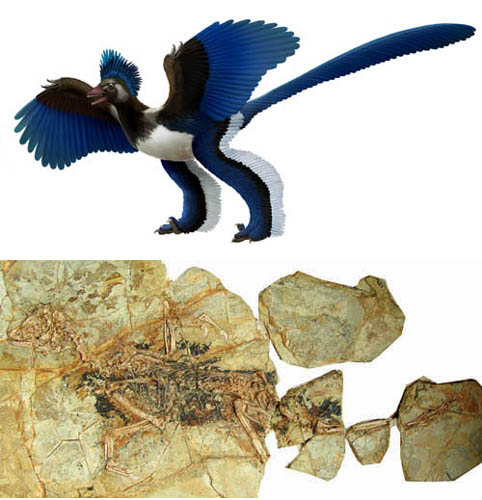| Location: Home > Research > Research Progress |
| Systematic Position of Archaeopteryx Challenged? |
|
Archaeopteryx has been considered the most primitive and earliest known bird ever since its discovery, and has been placed at the base of Avialae in nearly all numerical phylogenetic analyses. In 2011, a parsimony-based phylogenetic study incorporating information of a new Archaeopteryx-like theropod, Xiaotingia zhengi, shifted its position from within Avialae, the group that contains modern birds, to Deinonychosauria, a highly diverse group of predatory dinosaurs. Consequently, this new phylogenetic result has gained much attention and received immediate comments. One of these comments questioned the deinonychosaurian affinities of Archaeopteryx by applying probability-based methods to the same dataset and restoring Archaeopteryx to basal Avialae, suggesting these methods should be used more often in palaeontological studies. Is the systematic position of Archaeopteryx shifted?
In an article published online May 8 in the Journal of Systematic Palaeontology, Dr. XU Xing, Institute of Vertebrate Paleontology and Paleoanthropology (IVPP), Chinese Academy of Sciences, and Dr. Diego Pol, CONICET, Museo Paleontológico Egidio Feruglio, Argentina, reviewed two key issues: arguments recently advocated for the usefulness of probability-based methodologies in the phylogenetic reconstruction of basal birds and their close relatives, and support for different phylogenetic hypotheses. Their analysis demonstrates that Archaeopteryx represents a challenging taxon to place in the phylogenetic tree, but recent discoveries of derived theropods including basal avialans provide increased support for the deinonychosaurian affinities of Archaeopteryx.
Researchers compared character support for alternative placements of Archaeopteryx, discussed the character evidence that suggests the deinonychosaurian affinity of Archaeopteryx, and finally noted the simpler scenario in terms of major structural and ecological transformations of the deinonychosaurian hypothesis.
"Most importantly, we underscore that methodological choices should be based on the adequacy of the assumptions for particular kinds of data rather than on the recovery of preferred or generally accepted topologies, and that certain probability methods should be interpreted with caution as they can grossly overestimate character support”, said Diego Pol, coauthor of the study.
"Our analyses indicate that the shifting of Archaeopteryx to Deinonychosauria is a result of the wealth of new anatomical information and the unexpected combination of characters in newly discovered feathered dinosaurs closely related to the origin of Avialae. Real progress in determining the currently poorly supported phylogenetic affinities of Archaeopteryx will only be achieved through more detailed, extensive, and careful anatomical studies, as well as through the discovery of new taxa with unique combinations of characters”, said XU Xing, first author of the study.
This work was supported by the National Natural Science Foundation of China and CONICET of Argentina.
 Fig.1 Holotype of Xiaotingia zhengi, a Archaeopteryx-like theropod. (Image by XU Xing) |